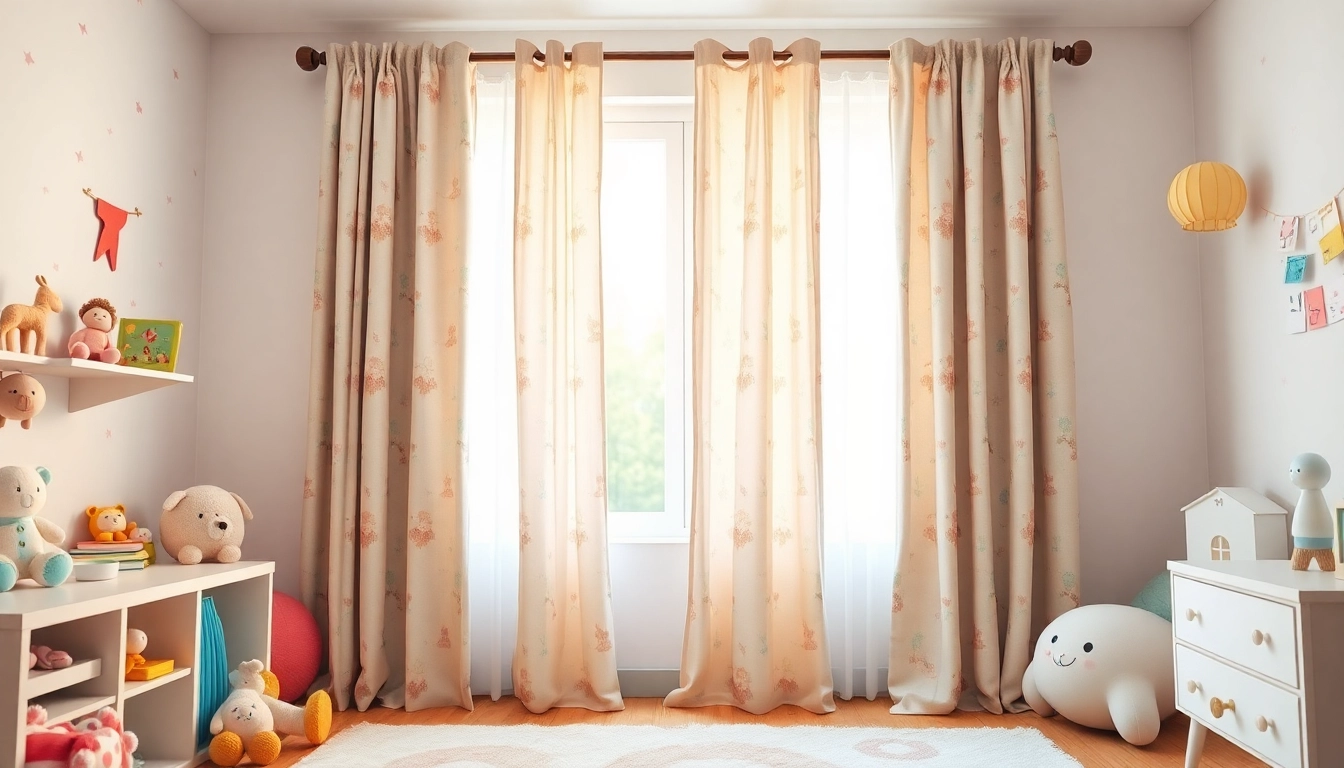Understanding Kids Room Curtains
What Are Kids Room Curtains?
Kids room curtains are window treatments specifically designed to cater to the aesthetics and functional needs of children’s spaces. Unlike standard curtains, these are often characterized by vibrant colors, playful patterns, and thematic designs that resonate with a child’s imagination. Curtains in kids’ rooms not only serve the practical purpose of light control and privacy but also enhance the room’s overall decor. They can transform an ordinary space into a whimsical retreat filled with personality and charm. For instance, a nursery might feature soft, sheer fabrics that filter light gently, while a teenager’s room may display bold graphics that reflect their unique style. Curtains can be a significant element in creating an inviting and comforting environment for children.
Importance of Choosing the Right Curtains
Selecting the right curtains for kids’ rooms is of paramount importance, not just for aesthetics but also for functionality and safety. The right choice can enhance a child’s mood, encourage imaginative play, and create a restful environment conducive to sleep. Moreover, factors such as light control, ease of maintenance, and even material safety are vital considerations. For example, blackout curtains in a toddler’s room can aid in better sleep by blocking out light, while light, breathable fabrics may be suitable in a playroom. Additional considerations include durability, as kids are prone to rough play, and the ability to withstand frequent washes, all while maintaining their vibrant colors and designs.
Common Styles and Patterns for Kids Rooms
The variety of styles and patterns available for kids room curtains is virtually endless. From classic themes like animals and fairy tales to modern geometric prints, there’s something to suit every child’s taste. Popular patterns include:
- Floral Patterns: Perfect for girls’ rooms, floral prints can add a soft, serene element to the décor.
- Animal Prints: These playful designs often include fun characters like dinosaurs, unicorns, and cartoon animals.
- Geometric Shapes: Bright and bold geometric designs appeal to both younger and older children, offering a contemporary feel.
- Themed Curtains: Curtains that align with a child’s favorite movie or show can also bring a touch of magic to their space.
Incorporating these designs thoughtfully can help create an emotionally responsive environment, appealing to children’s interests and sparking their creativity.
Factors to Consider When Selecting Kids Room Curtains
Material Choices for Safety and Durability
When it comes to choosing curtains for children, material selection is vital. Kids are often active and curious, which means their curtains need to withstand wear and tear. Look for materials that are both durable and easy to clean. Common fabrics include:
- Cotton: Soft, breathable, and easy to wash, cotton is a popular choice for kids’ curtains.
- Polyester: This synthetic fabric is durable and resistant to fading, making it ideal for vibrant, colorful designs.
- Blackout Materials: Ideal for naps and nighttime, blackout fabric can filter out light, ensuring a peaceful sleeping environment. These materials also add a layer of soundproofing to the room.
- Eco-Friendly Fabrics: Organic cotton and other sustainable materials are increasingly popular, appealing to eco-conscious parents looking for safe options for their children.
Always ensure the materials are free from harmful chemicals and allergens, creating a safe living space for your little ones.
Light Control: Sheers vs. Blackouts
One of the fundamental functions of curtains is to regulate light entering a room. When selecting kids’ room curtains, consider how much light you’d like to allow in. Sheer curtains provide a soft filter of light, creating a warm, airy feel while still affording some privacy. They are ideal for playrooms where natural light benefits creative activities. On the other hand, blackout curtains are much thicker and designed to completely block sunlight. These are well-suited for bedrooms where sleep is a priority, particularly for infants and toddlers who benefit from darker environments during naptime.
The choice between sheer and blackout often depends on the specific needs of your child—whether they require a space for stimulating activities or a tranquil sleeping environment. Surprisingly, combining both options can also create versatility; for instance, sheer curtains can be layered over blackout ones, allowing for flexibility throughout the day.
Design Considerations for Different Age Groups
As children grow, their tastes and needs evolve, making it essential to adapt window treatments accordingly. For babies and toddlers, opt for light-blocking curtains that ensure uninterrupted sleep patterns and are washable to handle spills and messes. Colorful patterns with animal motifs can stimulate their imagination.
In preschool-aged rooms, engage their blossoming personalities by introducing curtains featuring favorite characters or themes. As they transition into preteen years, look for styles that align with their developing sense of identity—think trendy prints or colors that resonate with their personal tastes.
Ultimately, selecting design elements that can transition with your child, such as curtains with neutral colors and patterns that are easy to accessorize, can prolong the life of your investment and maintain an appealing room aesthetic.
Best Practices for Curtain Maintenance
Cleaning and Care for Kids Room Curtains
Maintaining the cleanliness of kids’ room curtains is essential for hygiene and aesthetics. Given how active children are, these fabrics can quickly gather dirt, stains, and odors. Regular cleaning raises the lifespan of the curtains while keeping them looking fresh. Here are some best practices:
- Regular Washing: Check the label for washing instructions. Most cotton and polyester curtains can be machine washed. Aim to wash them every three to six months, or more frequently if they are in high-traffic areas.
- Spot Cleaning: For small stains or spills, employ a gentle spot-cleaning solution right away to prevent setting. A simple mix of mild detergent and water usually suffices.
- Air Drying: Wherever possible, allow curtains to air dry to maintain the integrity of the fabric and prevent shrinkage. If using a dryer, opt for a low heat setting.
- Ironing: If wrinkles occur, refer to the care label to determine the appropriate ironing temperature, ensuring the fabric remains in good condition.
How to Safeguard Curtains from Damage
Children’s rooms are often places of exploration, which can lead to potential damage to curtains. To safeguard your curtains, consider the following methods:
- Use Curtain Tiebacks: Encourage children to tie back curtains during the day. This not only brings in more light but also minimizes the chance of snagging and tearing.
- Secure Rods and Hardware: Ensure that curtain rods and any installed hardware are securely mounted. This prevents any accidents should they be tugged on.
- Choose Robust Hardware: Opt for heavy-duty curtain rods that can withhold the weight of thicker curtains while resisting bending or breaking under pressure from playful hands.
Storing Seasonal Curtain Variations
Changing curtains seasonally can refresh the look of a child’s room and adjust for seasonal changes in light and weather. When storing seasonal curtains, follow these guidelines:
- Clean Before Storage: Ensure that all curtains are spotlessly clean to prevent mold and mildew while stored.
- Use Storage Bags: Fabric storage bags can protect curtains from dust and pests. Avoid plastic bags which can trap moisture.
- Keep in a Dry Place: Store curtains in a climate-controlled environment to preserve the fabric and colors, preventing fading and deterioration over time.
Creative Ideas for Kids Room Curtain Designs
Ideas for Themed Rooms and Decorations
Themed rooms can captivate a child’s imagination and provide them with a personal retreat. Create coherence in a room’s design by matching curtains with wall colors, bedding, and decor. Popular themes may include:
- Jungle Safari: Choose curtains with animal prints or leafy designs, paired with stuffed animals and green decor.
- Under the Sea: Opt for ocean-themed curtains with blues, greens, and sea motifs, complementing accessories like fish or mermaid decorations.
- Space Exploration: Incorporate celestial patterns with stars and rockets in the curtains to create a vista of the universe for budding astronomers.
Combining Curtains with Other Window Treatments
For a more customizable approach to window treatments, combining curtains with other options expands their functionality and aesthetic appeal. Consider layering various treatments:
- Combining Blackouts with Sheers: Use blackout curtains as the main layer for light control, topped with sheer curtains for a softer look during the day.
- Matching Curtains and Blinds: Choose complementary colors or patterns in curtains and blinds to achieve a chic, coordinated appearance while benefitting from both privacy and light control.
Innovative DIY Projects for Custom Curtains
DIY curtains not only offer an opportunity to save money, but they also allow parents to express creativity and personalize their child’s environment. Here are some unique DIY ideas:
- Painted Patterns: Use fabric paint to create custom designs on plain, affordable curtains, allowing children to help paint their favorite characters or scenes.
- Fabric Collage: Cut fabric swatches in various shapes and sizes and sew them onto a simple curtain panel to create a fun, textured look.
- Nature-Inspired Curtains: Use leaf prints or even nature cut-outs to encapsulate outdoor elements, fostering an appreciation for nature right in their room.
Where to Buy High-Quality Kids Room Curtains
Top Retailers for Kids Curtains
When searching for kids room curtains that meet both aesthetic and functional criteria, consider top retailers known for their quality selections:
- Pottery Barn Kids: With a variety of playful designs, Pottery Barn Kids is known for high-quality fabrics and safe materials.
- Target: Offering a budget-friendly selection, Target combines affordability with trendy designs that appeal to children.
- Amazon: A one-stop-shop for all things kids, Amazon houses a myriad of options across all price ranges, including top-rated styles.
- Walmart: Known for competitive prices and a wide selection, Walmart can meet diverse needs and offers great in-store shopping experiences.
Online Vs. In-Store Shopping Experiences
The choice between online shopping and visiting a physical store can greatly impact the curtain selection process. Online shopping offers convenience and a broader selection, often accompanied by customer reviews. However, visiting a store allows parents to feel the fabric and visualize the color in person, ensuring a satisfactory purchase. Utilizing both methods can be an effective strategy: browse online to whip up ideas and make price comparisons, then visit local stores for final considerations and fabric assessment.
Customer Reviews and Recommendations
Customer reviews play a crucial role in assessing curtain quality and design. Sites like Amazon and retailer websites often feature customer feedback that can help gauge how a product performs in real-life settings. Pay attention to reviews on durability, ease of maintenance, and overall satisfaction. Additionally, seeking recommendations from other parents—whether in parenting groups or online communities—can lead to beneficial insights into brands and specific products that have proven effective in children’s rooms.






